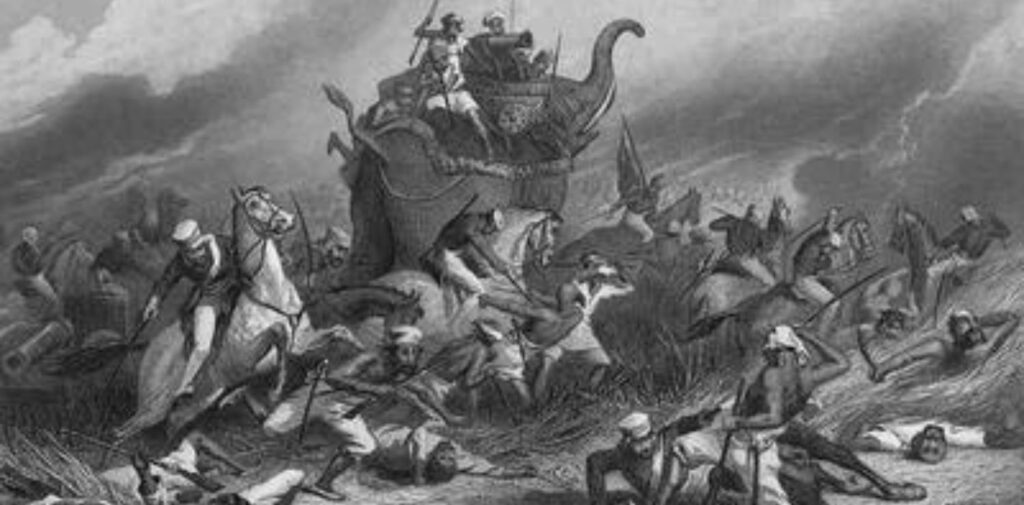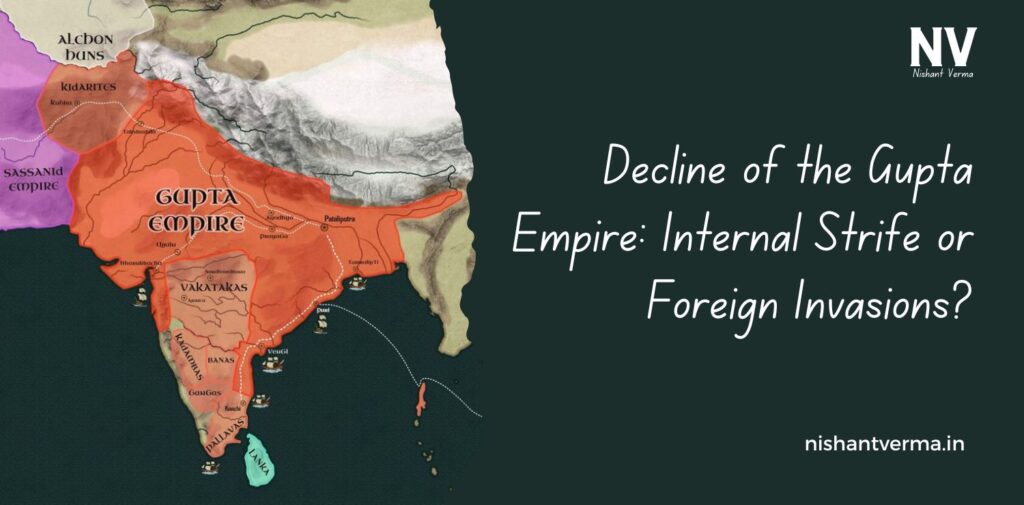The Gupta Empire, often regarded as a golden age in Indian history, lasted from around 320 CE to 550 CE. It was a period of great prosperity in India, marked by advancements in science, mathematics, art, literature, and culture. However, by the mid-6th century, the empire had significantly weakened and eventually collapsed. Historians have debated the reasons behind the decline of the Gupta Empire, with two main factors standing out: internal strife and foreign invasions. Both of these elements played crucial roles in the downfall of the Gupta Empire, and understanding them is key to grasping the empire’s decline.
Gupta Empire’s Rise and Its Glory
The Gupta Empire was founded by Chandragupta I, but it reached its peak under the leadership of his successors, particularly Samudragupta and Chandragupta II (also known as Vikramaditya). Under their reign, the empire expanded greatly, covering most of the Indian subcontinent. The Guptas are known for their achievements in governance, economy, and culture.
- Cultural Renaissance: The Gupta period saw significant progress in various fields. Scholars like Kalidasa, Aryabhata, and Varahamihira made groundbreaking contributions to literature, mathematics, and astronomy. The concept of zero and the decimal system were formalized during this period.
- Economic Prosperity: The Gupta Empire was prosperous due to its control over important trade routes, both inland and overseas. The economy flourished through trade, agriculture, and skilled craftsmanship.
- Political Stability: For several centuries, the Gupta rulers maintained control over a vast region. Their centralized administration, which was highly efficient, helped maintain peace and order. The rulers also supported local administration through alliances with regional kings, which helped to reduce internal conflicts.
However, this period of prosperity was not to last forever. By the 5th and 6th centuries, the Gupta Empire began to decline.

Internal Strife: The Weakened Core of the Gupta Empire
One of the primary reasons for the fall of the Gupta Empire was internal strife. This refers to the political instability, weak leadership, and challenges in administration that arose within the empire itself.
- Weak Successors: After the death of the powerful Chandragupta II, the Gupta Empire experienced a series of weaker rulers. While the early Gupta emperors were strong, capable, and had clear visions for the empire’s expansion and development, their successors lacked the same qualities. The weakening of the central authority led to a decline in the empire’s control over its territories. For example, after the reign of Skandagupta (who ruled from 455 to 467 CE), the Gupta Empire faced leadership challenges. There were no strong, charismatic rulers to hold the empire together, which allowed local rulers and provinces to gain more power and autonomy. This led to disunity and fragmentation.
- Administrative Challenges: The Gupta Empire was based on a decentralized administrative system. While this had worked well in the earlier stages, it became problematic as the empire expanded. The local rulers, who were given significant autonomy, began to act independently and did not always answer to the central government. This created a situation where the empire’s various regions were increasingly self-governing, and the Gupta rulers had less control over their lands. Moreover, the empire’s reliance on alliances and the support of regional kings weakened its ability to respond to challenges. As various regions became more independent, they also became more vulnerable to external threats.
- Economic Strain: The economic prosperity of the Gupta Empire started to decline in the 5th century. There were several reasons for this. One reason was the decline in trade. Trade routes, which were once the lifeblood of the Gupta economy, began to become less secure. Internal administration became ineffective in collecting taxes, which led to economic hardships for many regions. The empire also suffered from the mismanagement of resources, as various regions were now controlled by local rulers who were more focused on their interests than on the prosperity of the empire as a whole. The economic troubles were exacerbated by social unrest. Farmers, artisans, and traders faced hardships, which weakened the economic foundation of the Gupta state. This internal unrest, combined with the collapse of a unified system, contributed to the weakening of the empire.

Foreign Invasions: The External Threats to the Gupta Empire
Along with internal strife, foreign invasions played a critical role in the downfall of the Gupta Empire. During the 5th and 6th centuries, the empire faced a series of invasions that further weakened its structure and resources.
- The Huna Invasions: The most significant foreign threat to the Gupta Empire came from the Huns, a nomadic tribe from Central Asia. These invasions began in the mid-5th century when the Huns, under their leader Mihirakula, launched attacks on the northwestern parts of India. The Huns were fierce warriors, and their invasions caused widespread devastation in the Gupta territories. The Huns destroyed cities, looted wealth, and killed many people. They also forced many local rulers to pay tribute, weakening the Gupta Empire’s authority. The last great Gupta emperor, Skandagupta, managed to defend against the Huns for some time, but the prolonged warfare drained the empire’s resources. The empire’s military, weakened by constant conflict, could not cope with the pressure of external invasions. After Skandagupta’s reign, the Huns continued to invade, and the Gupta Empire’s ability to protect its borders diminished. These invasions destabilized the empire, leading to the eventual collapse of Gupta rule in many regions.
- Decline in Trade and Cultural Loss: As a result of these invasions, trade routes were disrupted, and many important cities were destroyed. This not only affected the economy but also led to a decline in cultural exchange. The loss of cities like Pataliputra (modern-day Patna), which was a major centre of learning, also led to a decline in intellectual and artistic achievements.
- Loss of Territory: The repeated invasions by the Huns resulted in the loss of vast territories of the Gupta Empire. Northern India, which was once a flourishing region under the Guptas, came under the control of the Huns and other local powers. The Gupta rulers were no longer in a position to defend their lands, and many regions broke away to form their kingdoms. This territorial fragmentation further weakened the empire, and the Gupta dynasty struggled to maintain control.

Conclusion: Decline of the Gupta Empire
The decline of the Gupta Empire cannot be attributed to just one factor; rather, it was the result of both internal strife and foreign invasions. Internal issues such as weak leadership, ineffective administration, and economic difficulties contributed significantly to the empire’s decline. The lack of strong central control and the growing power of local rulers weakened the empire from within.
On the other hand, the invasions by the Huns and other external threats put further pressure on the Gupta Empire. These invasions destroyed cities, disrupted trade, and drained the empire’s military and economic resources. The Gupta rulers were unable to defend their territory effectively, leading to the eventual fall of the empire.
By the middle of the 6th century, the Gupta Empire had fragmented into smaller kingdoms, and the once-great civilization that had been a beacon of knowledge, culture, and prosperity was no longer a unified force. Though the empire’s fall was inevitable due to these combined forces, its legacy continues to influence Indian culture, science, and art. The decline of the Gupta Empire is a reminder of how internal weaknesses and external threats can lead to the downfall of even the most powerful empires in history.




